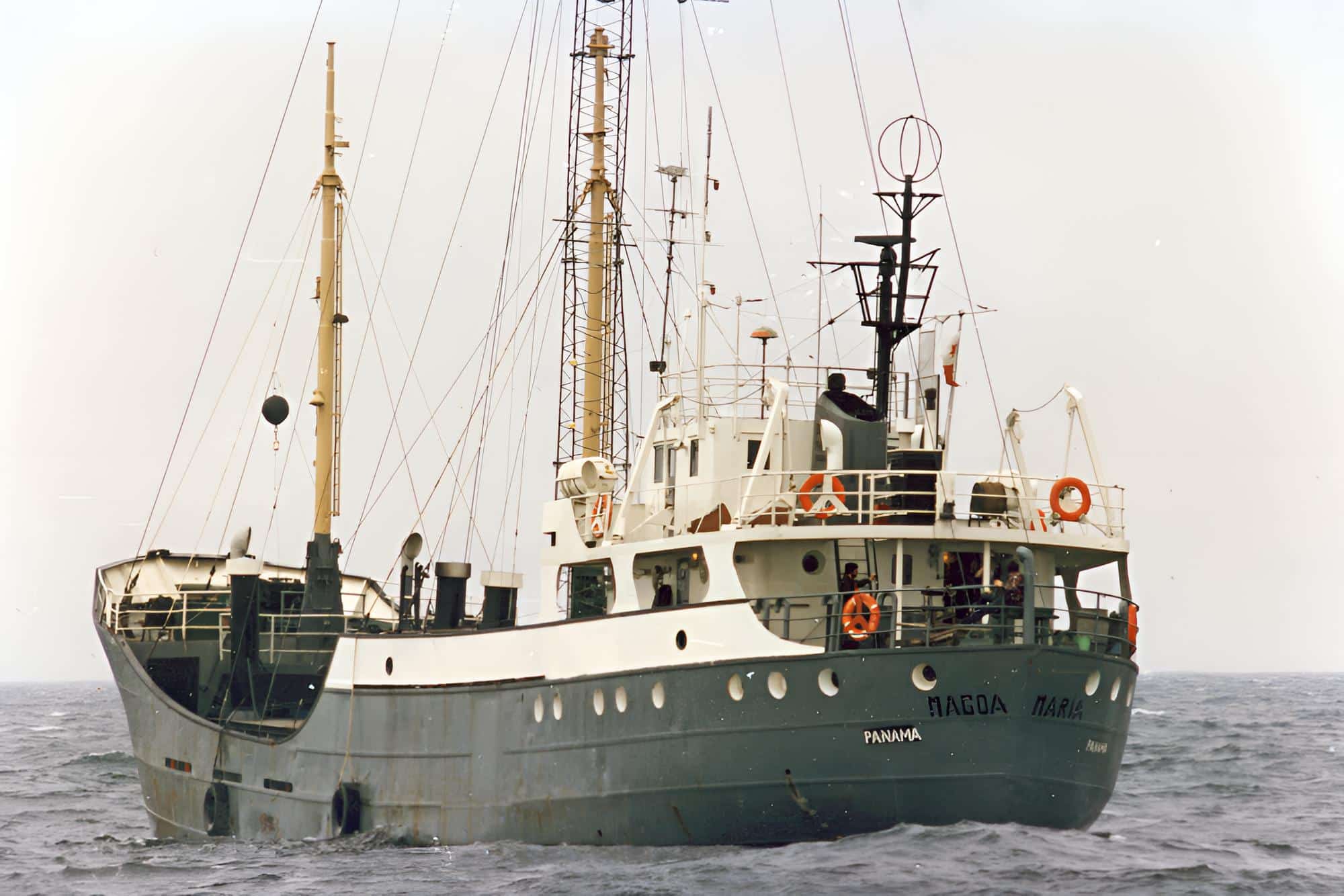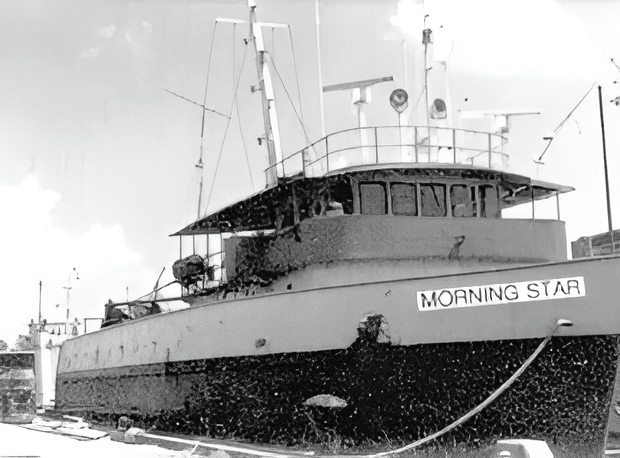Ship details: In 1957 the Hoheweg, 620 ton 170 feet long, was built during 1957 at Luhring in Brake, near Bremen, Germany. The Hoheweg made her maiden voyage on 2rd October, she was owned by Ludwig Ras of Bremen. In December 1979 the Hoheweg sailed for the last time for Ludwig Ras. A freight order was received from Oltmans in Bremen. The ship had been registered in Panama and renamed MV Lieve by the company Panlieve SA. Radio Paradijs purchased the MV Lieve for 80,000 Guilders with the help of Baremar Shipping Company of Spijkenisse, near Rotterdam and the Chielimsky Shipping Company of Rotterdam. After the Mi Amigo sank in March 1980, Danny Vuylsteke started Radio Paradijs. The ship was renamed Corunna for a period of two months. A captain was approached in a public house to sail the ship to Cuxhaven, Germany. Later he was discovered to be a skipper of a police boat, and the Paradijs organisation found themselves under investigation. The ship was moved to Cuxhaven, Germany and work was started on converting her into a radio ship. Shortly afterwards the ship was renamed MV Lieve. In early 1981 the ship sailed for Ireland, on the way they ran into a force twelve / thirteen storm. A lot of damage was done to the ship and they had to broadcast an S O S message. The ship was towed into Southampton. For the next two weeks the ship was repaired. On March 11th the Lieve arrived at Liffey’s North wall, Dublin, Ireland. Work recommenced on installing the mostly American broadcasting equipment, under the disguise that the ship was being fitted out for marine life research. In May Danny Vuylsteke quit, having spent about 10,000,000 Belgian Francs of his own money. Not knowing if the ship was registered or not the ship was renamed Magda Maria and registered in Panama. On 14th July the Dublin firm of Prendergast Aerials were paid about £40,000 to supply and erect the 88 metre (280 feet) aerial mast, the work being carried out a few hours before the ship departed. A large crowd gathered as the ship set sail, it was said the ship had been fitted out as a floating computer sales office. On board the ship were Chris Carey and Bob Noakes. Chris Carey offered $250,000 for the ship and all the equipment – they were removed from the ship. The ship left in a hurry, a large cable drum had been left on the deck. An Irish newsman hired a small aircraft and took some photographs of the ship on its journey. Five hours after leaving Ireland the top forty-eight metres of the mast collapsed leaving about forty metres (130 feet).
On 20th July 1981 the MV Magda Maria anchored nine miles north of the REM island. On 1st August 06:10 hours the Dutch Marine and water police boarded the Magda Maria, it did not take long to find that the ship did not have a qualified skipper on board, and that the name on the ships papers referred to her old name. The frigate HMS Jaguar towed the Magda Maria into IJmuiden harbour, arriving at 15:00 hours. The ship was then taken to Amsterdam Entrepot harbour, arriving at 17:30 hours. The owners took the case to court.
In 1983 a small victory was won by the owners of the station when the Dutch courts finally ruled that the seizure of the ship was unlawful. On 12th September 1985 the court case relating to the release of the ship was adjourned to 23rd January 1986. The Dutch Government claimed they needed more information on the registration of the Magda Maria at the time she was seized by the Dutch Navy in 1981. On 29th May 1986 the courts ruled that the ship must be given back to its owners. Two days later the Dutch Authorities wrote a letter to Kees Borrel, informing him that the ship was going to be handed back. The ship had not been guarded while it had been impounded and most of the equipment had been stolen, and the ship had deteriorated into a bad condition. The owners of the Magda Maria ordered the harbour authorities to seal the ship, which was being held in Entrepothaven in Amsterdam. On March 30th 1989 the Magda Maria was towed into Zeebrugge harbour in Belgium, before being taken to De Brugse Scheepssloperij – Denolf Recycling nv scrap yard (Boudewijnkanaal, Lodewijk Coiseaukaai in Brugge/Belgium), and broken up.
Offshore radio station: Radio Paradijs from 24th to 31st July 1981
Location: International waters off the Dutch coast

“Morning Star” (Radio Star of Hope) Project:
Paul Rusling reports: “The only involvement I had was via HIGH ADVENTURE MINISTRIES of California. We set up a couple of stations for them on land in other parts of the world. Not always licensed! in January 1987 we wanted to buy a ship to make Christian broadcasts, and were going to buy the Communicator, but Ray Anderson was a difficult seller and wanted too much money. We brought a full Lloyds surveyor along for a weeks work, so took him to Holland to inspect a ship owned by my old friend Ben Bode, the Radio Paradise ship. It was chained up in the Entrepot Harbour in East Amsterdam. It had been there a couple of years. It seemed to be OK. There was a lot of equipment still on board.
The President of High Adventure, a nice guy called George Otis, called some contacts in the Netherlands and we quickly made arrangements to make a TV programme on the ship. We did that early afternoon the same day, a short simple religious service, and some words about how the ship could be bringing the word of the Lord to millions if people sent money in very quickly. A banner was hung over the bows proclaiming the name of the ship The Morning Star (Christians will know this has significance).

There was a very strange moment in that programme when the wind, which was bad that day, just dropped to a still calm while we all prayed. I remember this like it was only yesterday. A few days later, we discovered that at that moment, the wind in the Knock Deep was VERY bad, and it tore down the masts on the M.V. Communicator and wrecked them,. We know this for sure, as we went to the Communicator later that week to survey the ship, before making an offer. Ray never accepted their offer.
The TV programme was transmitted the next day on satellite in Europe and many stations in the USA. I understand a lot of people sent in a lot of money. We were paid very well for the work we did, but we did not secure deal with Ben Bode, who was angry because the TV program was made on his ship without his permission, and he got no ‘location fee’. Ben and I now laugh about this time over a beer, when we get a chance (he lives in Antwerpen these days).”
